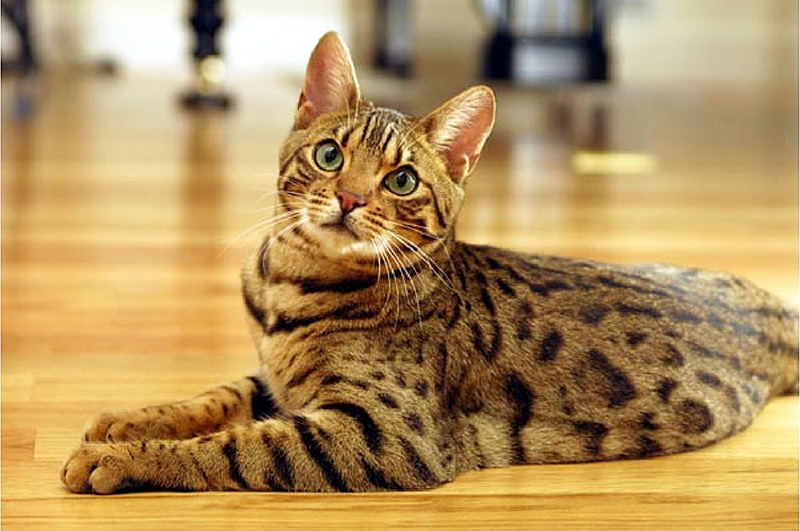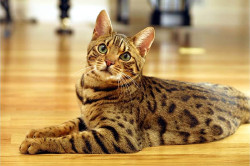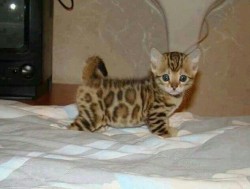Average lifespan: ten to 15 years.
Temperament: friendly and affectionate, intelligent and lively; playful into adulthood.
Weight: males 6.8 to 9kg; females 4.5 to 5.4kg.
Availabilty: easy.
Colours: brown spotted, brown marble and snow spotted Bengals can be shown at championship status with the Governing Council of the Cat Fancy (GCCF).
Grooming: a regular brush then a rub over with a chamois leather to get rid of any loose hairs.
Bengal cat breed history
The Asian Leopard Cat was bred with the domestic cat (starting with Abyssinians, Burmese and Egyptian Maus) in the 1980s by paediatrician Dr Willard Centerwall, who was attempting to transfer the leopard’s immunity to feline leukaemia to its tamer cousin. Unfortunately, the resistance didn’t pass on to the first generation. Most of the offspring were taken on by Jean Mill, who continued to breed them until — after overcoming a number of obstacles — the breed was recognised by The International Cat Association (TICA) in 1983.
Bengal cat breed looks
The Bengal cat is a ‘wild’ looking domestic cat. The standard calls for a large, sleek, very muscular cat with hindquarters that are slightly higher than the shoulders, and a thick tail that is carried low. The Bengal cat’s head is rounded and slightly longer than it is wide.
The nose is broad and the muzzle full, with a light coloured, strong rounded chin and pronounced whisker pads created by wide-set canine teeth. The ears are medium to small with rounded tips pointing forward in profile.
Bengal cat breed characteristics and personality
Bengal cats are said to be loyal, loving and will quickly become part of your family, mixing well with children and other animals. Some of the Bengal cat’s wild instincts have been retained, including a love of water, so owners are advised to keep toilet seats closed and expect to see their Bengal cats drinking from a tap.
Bengal kittens
When buying a Bengal kitten, you should look for a bright-eyed, playful kitten from a recognised breeder. Try to see the litter with their parents as well. Sue says that if the kittens have been socialised properly, they should be outgoing and willing to be handled all over. Be wary of kittens that hide from you if they are past seven weeks old.
Rescue a Bengal cat
Bengal Cat Club has a popular and active welfare page, managed by Tracy Wilkinson. The organisation is keen to remind potential owners that, instead of buying a kitten, there are always much loved adult Bengals who sadly need new homes.
Bengal cat breed health and lifestyle
Bengal cats don’t like to be left alone for long so if you’re going to be out at work all day it’s best to get two so they will keep themselves amused. The challenge is keeping up with their energy levels and intelligence.
Bengals are generally healthy and quite robust. Barrie says: “Their health is quite stable now that they have moved away from earlier generations and there are no inherited diseases specific to the breed.” Reputable breeders will make sure they conduct DNA tests, as with all breeds, to ensure that their cats are not carriers of any diseases.
source: http://www.yourcat.co.uk/Cat-Breed-Profiles/bengal-cat-breed-profile.htmlboardboardboardboard



